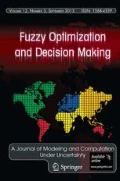Abstract
The aim of this paper is to investigate a novel approach to group decision making based on DEA cross-efficiency with intuitionistic fuzzy preference relations, which can avoid information distortion and obtain more credible decision making results. An interval transform function is defined, which can transform an intuitionistic fuzzy preference relation into an interval multiplicative preference relation. Then, an interval transform function based data envelopment analysis model is developed to obtain the ranking vector of consistent intuitionistic fuzzy preference relation, in which each of the alternatives is viewed as a decision making unit. Moreover, for any intuitionistic fuzzy preference relations, we propose two DEA cross-efficiency models to get the cross-efficiency values of all alternatives, and we can calculate the normalized intuitionistic fuzzy priority weight vector of the intuitionistic fuzzy preference relation based on the cross-efficiency values. A goal programming model is investigated to derive the weight vector of decision makers. A step-by-step procedure for group decision making approach based on DEA cross-efficiency with intuitionistic fuzzy preference relations is presented. Finally, numerical examples are given to illustrate the validity and applicability of the proposed method. This is the first attempt of employing the DEA cross-efficiency to the group decision making with intuitionistic fuzzy preference relations.
Similar content being viewed by others
References
Atanassov, K. T. (1986). Intuitionistic fuzzy sets. Fuzzy Sets and Systems, 20(1), 87–96.
Doyle, J., & Green, R. (1994). Efficiency and cross-efficiency in DEA: Derivations, meanings and uses. Journal of the Operational Research Society, 45(5), 567–578.
Herrera-Viedma, E., Herrera, F., Chiclana, F., & Luque, M. (2004). Some issues on consistency of fuzzy preference relations. European Journal of Operational Research, 154(1), 98–109.
Liang, L., Wu, J., Cook, W. D., & Zhu, J. (2008). The DEA game cross-efficiency model and its nash equilibrium. Operations Research, 56(5), 1278–1288.
Liao, H., & Xu, Z. (2014). Priorities of intuitionistic fuzzy preference relation based on multiplicative consistency. IEEE Transactions on Fuzzy Systems, 22(6), 1669–1681.
Liao, H., Xu, Z., Zeng, X., & Merigo, J. M. (2015). Framework of group decision making with intuitionistic fuzzy preference information. IEEE Transactions on Fuzzy Systems, 23(4), 1211–1227.
Liu, J., Xu, Q., Chen, H., Zhou, L., Zhu, J., & Tao, Z. (2017). Group decision making with interval fuzzy preference relations based on DEA and stochastic simulation. Neural Computing and Applications. https://doi.org/10.1007/s00521-017-3254-7.
Meng, F., Tang, J., & Xu, Z. (2017). A 0-1 mixed programming model based method for group decision making with intuitionistic fuzzy preference relations. Computers & Industrial Engineering, 112, 289–304.
Ramanathan, R. (2006). Data envelopment analysis for weight derivation and aggregation in the analytic hierarchy process. Computers & Operations Research, 33(5), 1289–1307.
Saaty, T. L. (1977). A scaling method for priorities in hierarchical structures. Journal of Mathematical Psychology, 15(3), 234–281.
Saaty, T. L. (1980). The analytic hierarchy process. New York: McGraw-Hill.
Saaty, T. L., & Vargas, L. G. (1987). Uncertainty and rank order in the analytic hierarchy process. European Journal of Operational Research, 32(1), 107–117.
Wang, Z. (2013). Derivation of intuitionistic fuzzy weights based on intuitionistic fuzzy preference relations. Applied Mathematical Modelling, 37(9), 6377–6388.
Wang, Z. (2015). A note on “A goal programming model for incomplete interval multiplicative preference relations and its application in group decision-making”. European Journal of Operational Research, 247(3), 867–871.
Wang, Y., Chin, K. S., & Poon, G. K. K. (2008). A data envelopment analysis method with assurance region for weight generation in the analytic hierarchy process. Decision Support Systems, 45(4), 913–921.
Wu, J., Chiclana, F., & Liao, H. (2018). Isomorphic multiplicative transitivity for intuitionistic and interval-valued fuzzy preference relations and its application in deriving their priority vectors. IEEE Transactions on Fuzzy Systems, 26(1), 193–202.
Xia, M., & Chen, J. (2015). Studies on interval multiplicative preference relations and their application to group decision making. Group Decision and Negotiation, 24(1), 115–144.
Xu, Z. (2007a). A survey of preference relations. International Journal of General Systems, 36(2), 179–203.
Xu, Z. (2007b). Intuitionistic preference relations and their application in group decision making. Information Sciences, 177(11), 2363–2379.
Xu, Z. (2012). An error-analysis-based method for the priority of an intuitionistic preference relation in decision making. Knowledge-Based Systems, 33, 173–179.
Xu, Z. (2013). Compatibility analysis of intuitionistic fuzzy preference relations in group decision making. Group Decision and Negotiation, 22(3), 463–482.
Xu, Z., & Cai, X. (2010). Recent advances in intuitionistic fuzzy information aggregation. Fuzzy Optimization and Decision Making, 9(4), 359–381.
Xu, Z., & Liao, H. (2015). A survey of approaches to decision making with intuitionistic fuzzy preference relations. Knowledge-Based Systems, 80(5), 131–142.
Xu, Z., & Xia, M. (2014). Iterative algorithms for improving consistency of intuitionistic preference relations. Journal of the Operational Research Society, 65(5), 708–722.
Zhang, X., & Xu, Z. (2012). A new method for ranking intuitionistic fuzzy values and its application in multi-attribute decision making. Fuzzy Optimization and Decision Making, 11(2), 135–146.
Acknowledgements
The work was supported by National Natural Science Foundation of China (Nos. 71501002, 61502003, 71871001, 71771001, and 71701001), Anhui Provincial Natural Science Foundation (Nos. 1608085QF133, 1508085QG149), Anhui Provincial Philosophy and Social Science Planning Youth Foundation (No. AHSKQ2016D13).
Author information
Authors and Affiliations
Corresponding author
Rights and permissions
About this article
Cite this article
Liu, J., Song, J., Xu, Q. et al. Group decision making based on DEA cross-efficiency with intuitionistic fuzzy preference relations. Fuzzy Optim Decis Making 18, 345–370 (2019). https://doi.org/10.1007/s10700-018-9297-0
Published:
Issue Date:
DOI: https://doi.org/10.1007/s10700-018-9297-0




